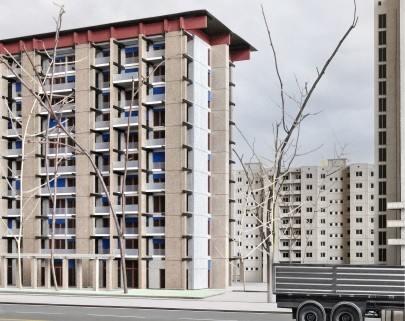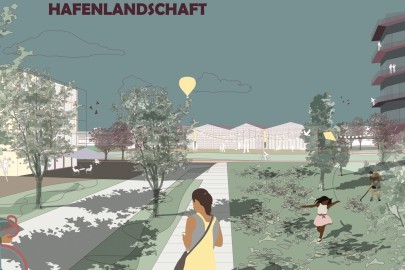FoodTura – Campus der Zukunft in Rom
Published by the Department of Design and Building Technology (Prof. Anett-Maud Joppien)
In a world of abundance, where enough food is produced, hunger must have no place. At the heart of the global challenge of the food crisis is the United Nations World Food Programme (WFP) in Rome.
The project aims to revitalize and reinvent a site that has been abandoned for decades – a former grain storage facility called Granaio dell’Urbe – and to connect it both functionally and urbanistically with the surrounding neighborhood and the city. The building and its surroundings are intended to form the essential global platform for the new WFP campus.

Serie 2050
Published by the Department of Design and Industrial Methods of Building Construction (Prof. Martin Baur / Florian Latsch)
It is estimated that today nearly two-thirds of Ukrainians live in standardized housing types, built in large numbers between the 1950s and 1980s. Already, more than 130,000 residential buildings have been destroyed in the ongoing war. The reconstruction will therefore largely focus on creating housing. Much of this rebuilding will also take place in socialist mass housing estates. The similarity and interchangeability of these settlements encourages approaching the design of a replacement building for a destroyed structure as a case study. For this purpose, we go to Odessa in southern Ukraine, specifically to the socialist housing estate Cheryomushki, where we design a new building, hopefully called Serie 2025.
This endeavor requires both defiant optimism and a persistent culture of joy and vitality. Our external perspective is intended not from an imperialist “know-it-all” standpoint, but from a diverse viewpoint, which can generate pluralistic and potentially surprising questions and answers.

Hafendreieck Mannheim
Published by the Department of Design and Urban Planning (Prof. Torsten Becker)
The master’s thesis focuses on developing an urban strategy and a detailed design for the HafenTriangle in Mannheim. The area, currently dominated by transportation infrastructure and port uses, is to be transformed into an urban quarter, better connecting Mannheim’s city center to the Rhine. Existing traffic infrastructures cutting through the site are to be overcome, integrated, or partially removed.
By incorporating the historic building stock, a complex program is to be developed, including universities, research facilities, creative workplaces, leisure, sports, retail, gastronomy, accommodation, cultural uses, housing, and attractive public spaces. The site’s dynamic urban topography offers a wide variety of spatial situations, enabling a strong and expressive urban composition.

Silent Silhouettes – Additiv gefertigte Akustikabsorber aus Ton
Published by the Department of Digital Design Unit (Prof. Dr.-Ing. Oliver Tessmann)
Increasing noise levels in urban environments make it necessary to rethink sustainable materials for room acoustics. (Astrauskas et al., 2020) Conventional acoustic materials are often made of plastic foam and are difficult to recycle. Silent Silhouettes investigates clay as an exemplary building material – a traditional material that is seeing renewed use in contemporary architecture. While its climate-regulating and hygrothermal properties are well documented, its acoustic potential remains largely unexplored. (Fischer et al., 2021) This research addresses this gap by exploring the potential of developing clay into an effective sound absorber through additive manufacturing.


